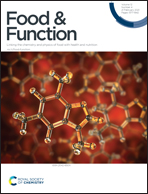Improving in vitro bioaccessibility and bioactivity of carnosic acid using a lecithin-based nanoemulsion system†
Abstract
As a phenolic terpenoid, carnosic acid (CA) mainly exists in rosemary, which can be effectively used for the treatment of degenerative and chronic diseases by taking advantage of its health-promoting bioactivities. However, the low solubility and dissolution of CA in aqueous solutions at ambient and body temperatures result in low stability and bioaccessibility during the digestion process, which limits its application scope in the functional foods industry. In this regard, a lecithin based nanoemulsion system (CA-NE) is employed in the present work to enhance the bioaccessibility and bioactivities of CA. It is revealed that the CA-NE under investigation exhibits high loading capacity (2.80 ± 0.15%), small particle size (172.0 ± 3.5 nm) with homogeneous particle distribution (polydispersity index (PDI) of 0.231± 0.025) and high repulsive force (zeta potential = −57.2 ± 0.24 mV). More importantly, the bioaccessibility of CA-NE is improved by 2.8-fold compared to that of CA in MCT oil. In addition, the cellular antioxidant assay (CAA) and cellular uptake study of the CA-NE in HepG2 cell models demonstrate a longer endocytosis process, suggesting the well-controlled release of CA from CA-NE. Furthermore, an improved anti-inflammatory activity was evaluated via the inhibition of the pro-inflammatory cytokines, nitric oxide (NO) and TNF-α production in LPS-stimulated RAW 264.7 macrophage cells. The results clearly demonstrated a promising application of CA-NE as a functional food.



 Please wait while we load your content...
Please wait while we load your content...